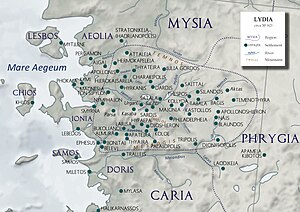Mastaura (Caria)
Mastaura | |
|---|---|
| Coordinates: 37°57′23″N 28°20′30″E / 37.956332°N 28.341756°E | |
| Country | Turkey |
| Province | İzmir |

Mastaura (
Some sources speak of the town as originally belonging to Lydia, a kingdom into which Croesus (560-546 BC) briefly incorporated Caria.[1][2]
Pliny the Elder mentions the town as dependent on Ephesus as its provincial capital and thus as belonging in his time (1st century AD) to the Roman province of Asia[3] which, under the Roman Empire, incorporated Caria.
In
Location
Mastaura was situated in the north of
The geographer
Its site is located near
Remains
Recently the remains of a Roman-era amphitheatre dating from about 200 AD[11] and holding up to 20,000 spectators have been discovered still standing to a considerable height.[12] It is only the third amphitheatre to be found in Turkey.
Coinage
Mastaura had the privilege of having a mint and some of its coins are extant.[5][2]
Bishopric
No longer a residential bishopric, Mastaura in Asia is today listed by the Catholic Church as a titular see.[15]
References
- ISBN 978-0-19-926337-0. Retrieved 11 December 2021 – via Google Books.
- ^ a b "Our objects and artworks". The Fitzwilliam Museum. Retrieved 11 December 2021.
- ^ Pliny the Elder, The Natural History, Book V, chapter 31
- ^ Magazine, Smithsonian; Gershon, Livia. "In Ancient Turkey, Gladiators Fought at This Colosseum-Like Amphitheater". Smithsonian Magazine. Retrieved 11 December 2021.
- ^ a b "Dictionary of Greek and Roman Geography (1854), MAACAH, MASSICYTES, MASTAURA". Perseus.tufts.edu. Retrieved 11 December 2021.
- ^ "Istanbul Guide, "Carie ... Mastaura & Harpasa"". Istanbulguide.net. Archived from the original on 3 March 2016. Retrieved 11 December 2021.
- ^ "Strabo, Geography, Book 14, chapter 1". Perseus.tufts.edu. Retrieved 11 December 2021.
- ^ Lund University. Digital Atlas of the Roman Empire.
- ISBN 978-0-691-03169-9.
- ^ Hamilton, William John (11 December 1842). "Researches in Asia Minor, Pontus and Armenia: With Some Account of Their Antiquities and Geology". J. Murray. Retrieved 11 December 2021 – via Google Books.
- ^ "Encuentran un anfiteatro romano en la antigua ciudad de Mastaura en Anatolia". Terraeantiqvae.com. Retrieved 11 December 2021.
- ^ Laura Geggel (20 April 2021). "Gladiator arena from Roman era unearthed in Turkey". Livescience.com. Retrieved 11 December 2021.
- OCLC 955922585.
- ^ Pascal Culerrier, Les évêchés suffragants d'Éphèse aux 5e-13e siècles, in Revue des études byzantines, vol. 45, 1987, p. 157
- ISBN 978-88-209-9070-1), p. 925
![]() This article incorporates text from a publication now in the public domain: Smith, William, ed. (1854–1857). "Mastaura". Dictionary of Greek and Roman Geography. London: John Murray.
This article incorporates text from a publication now in the public domain: Smith, William, ed. (1854–1857). "Mastaura". Dictionary of Greek and Roman Geography. London: John Murray.

